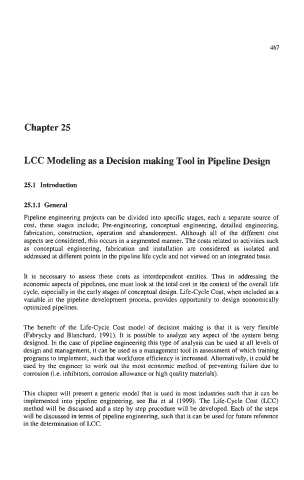Page 500 - Pipelines and Risers
P. 500
467
Chapter 25
LCC Modeling as a Decision making Tool in Pipeline Design
25.1 Introduction
25.1.1 General
Pipeline engineering projects can be divided into specific stages, each a separate source of
cost, these stages include; Pre-engineering, conceptual engineering, detailed engineering,
fabrication, construction, operation and abandonment. Although all of the different cost
aspects are considered, this occurs in a segmented manner. The costs related to activities such
as conceptual engineering, fabrication and installation are considered as isolated and
addressed at different points in the pipeline life cycle and not viewed on an integrated basis.
It is necessary to assess these costs as interdependent entities. Thus in addressing the
economic aspects of pipelines, one must look at the total cost in the context of the overall life
cycle, especially in the early stages of conceptual design. Life-Cycle Cost, when included as a
variable in the pipeline development process, provides opportunity to design economically
optimized pipelines.
The benefit of the Life-Cycle Cost model of decision making is that it is very flexible
(Fabrycky and Blanchard, 1991). It is possible to analyze any aspect of the system being
designed. In the case of pipeline engineering this type of analysis can be used at all levels of
design and management, it can be used as a management tool in assessment of which training
programs to implement, such that workforce efficiency is increased. Alternatively, it could be
used by the engineer to work out the most economic method of preventing failure due to
corrosion (i.e. inhibitors, corrosion allowance or high quality materials).
This chapter will present a generic model that is used in most industries such that it can be
implemented into pipeline engineering, see Bai et a1 (1999). The Life-Cycle Cost (LCC)
method will be discussed and a step by step procedure will be developed. Each of the steps
will be discussed in terms of pipeline engineering, such that it can be used for future reference
in the determination of LCC.

